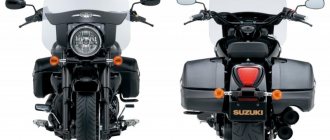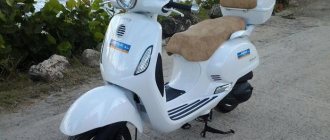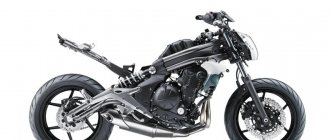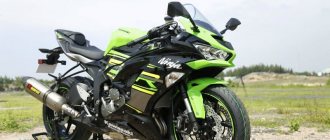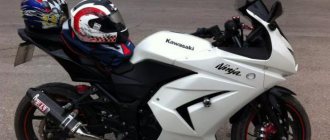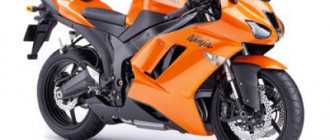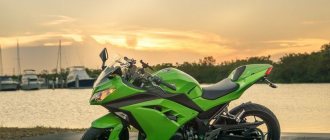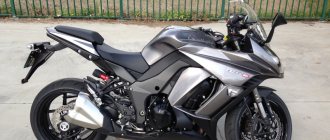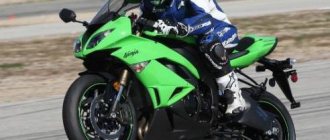The Kawasaki Vulcan 1500 cruiser is a modified version of its predecessor, the VN-15 model, produced since the 80s of the last century, although until 2000 both models were produced in parallel. The Kawasaki VN1500 Vulcan itself lasted on the assembly line until 2009, despite the fact that since 2003 the more powerful VN1600 was produced simultaneously with it. Such a long life of the model is explained by a successful combination of advantages - an affordable price for a one and a half liter cruiser , stylish appearance and good reliability . Countless copies of this bike continue to travel on the roads of Russia and other countries, and will probably continue to do so for a long time.
Design
The Vulcan Classic is a classic cruiser inspired by Harley-Davidson. The massive and elongated bike has visually become much more stocky than the VN-15, and at the same time acquired even more chrome (the quality of which is a separate issue). The vintage appearance ensured the bike’s love among chopper riders, despite the fact that many parts of the body kit of the Kawasaki VN1500 Vulcan are made of plastic, and not of “honest” iron, as on Harley-Davidsons. But the motorcycle already weighs a lot, so it’s even better, otherwise it would be completely unliftable.
Chassis and brakes
The tubular steel body looks stylish and bold. The elements are matched to match each other, and the overall impression is that the motorcycle poses a challenge. The frame conveys the strength of the motorcycle, its unbridled temper and undisguised perfection.
The rear brakes are served by a single disc with a diameter of 270 millimeters. It is paired with a single-piston caliper. The front brake is a three-hundred-millimeter disc complete with a two-piston caliper. Together, these brakes are able to stop the car at the right moment, despite all its potential.
The spoked wheels of this monster fascinate with their magnificence! Maintained in a strict style, they nevertheless emphasize the brilliance of the entire model. Alloy wheels would not be so relevant here. In general, as a rule, the cast version looks good on sports bikes, and the spoked version looks good on classic ones.
The steering wheel of the car is of medium size, but it matches the dimensions. It will be comfortable for a person of average height and will allow good control of the 1500 Vulcan both on the road and on slight off-road conditions. In addition, it looks stylish and is one of the key details in the design of the bike.
The rear suspension has 87 millimeters of travel. This is a pendulum version, equipped with two shock absorbers. A 41mm telescopic fork acts as the front suspension. Its stroke is 150 millimeters. For the VN 1500 Vulcan you don’t need anything more.
Specifications
The generally balanced technical characteristics became especially good a few years after the start of production of the Kawasaki Vulcan 1500. The first few years the bike had too much in common with the outdated and overly archaic VN-15, but later it was refined and became noticeably different from its “ancestor” . We can’t say that the bike stands out in any way from its competitors, but it can be safely called a strong mid-ranger. A solid cruiser with an engine capacity comparable to that of a car – isn’t that enough to love it?
Engine
The 1470 cc 4-valve V-Twin liquid-cooled engine migrated to the Vulcan 1500 Classic from the VN-15 virtually unchanged. The impressive power unit produces 65 hp. at 4700 rpm , and the maximum torque of 112 Nm (114 for injection modifications) is available already at 3000 rpm . “Tractor” traction is one of the reasons for the popularity of the Kawasaki VN 1500. The top gear can be engaged already at 60-70 km/h, and you can be sure that the bike will take this calmly. It is worth keeping in mind that until 1999 these motorcycles were equipped with a carburetor, and since 2000 - with an injector. Instances with a fuel injection system received the prefix Fi ( Fuel injection ) in the name. As for acceleration from 0 to 100 km/h , it varies from 5 seconds for the Mean Streak to almost 7 seconds for the Nomad.
Transmission
For the first two years, the Kawasaki VN 1500 was equipped with a 4-speed transmission , reliable, but very ancient - it was inherited from the VN-15. All newer copies were equipped with gearbox-5 , and this modification had almost no effect on the dynamics. The gearbox does not seem to operate very smoothly, but it is distinguished by excellent reliability, and owners rarely complain about problems with it.
Chassis and brakes
Here the archaic nature of the Vulcan Classic manifested itself in all its glory. Steel frame , massive engine - hello, three hundred kilograms of weight! However, the bike’s suspension is not bad, despite the significant unsprung weight due to the cardan drive. But the brakes are weak on all versions except the Mean Streak, and they are objectively not enough to effectively stop a heavy motorcycle capable of accelerating to 180 km/h . But, although the Kawasaki VN1500 Vulcan is capable of such speeds, it is better not to risk it - already at 140-150 km/h the bike turns into a cast-iron anvil, flying along the road strictly in a straight path.
Electronics
All the electronic stuff comes together in a compartment located in the bowels of the bike, under the saddle, where it is reliably protected from the weather. There is nothing extraordinary about it - a standard wiring between optics, ignition, generator and battery, assembled together in a switch, which bikers usually call simply “brains”.
Weight and dimensions
Despite the attempts of Japanese engineers to lighten the design, the motorcycle still turned out to be large and heavy . Vulcan Classic weighs from 292 kg , and this is a dry weight without fuel, oil and other liquids, while for Nomad this parameter reaches 337 kg . But we must give it its due - thanks to the center of gravity shifted downwards, this weight is not felt at all, and even a puny motorcyclist will not have problems parking when the bike has to be rolled back and forth with its legs a little. But the wide steering wheel creates certain inconveniences when driving around the city.
Controllability
At low speeds the bike is difficult to control due to its size, weight and tendency to tip over . At its maximum speeds, the picture is also sad, and making the Kawasaki VN 1500 change direction at 150 km/h is not so easy. But let's be fair - otherwise it handles well, and in the range from 20 to 120 km/h there are no problems with taxiing.
Fuel consumption
On average, gasoline consumption for the Kawasaki VN1500 Vulcan starts at 6.5 liters per 100 km , but in reality it can be noticeably higher. In the city it easily comes out to about 8 liters, and about the same amount will be obtained when driving on the highway at a cruising speed of 130 km/h. Injection modifications differ slightly in consumption from carburetor modifications. But they are quite capricious, and the injector can fail if you fill the tank with low-quality gasoline, which the carburetor can easily handle.
Repair and tuning
Doing it yourself always saves money. This is one of the advantages of archaic cruisers, which can be repaired or serviced on your own, armed with a manual and a set of tools.
Repair
You can repair the Kawasaki Vulcan 1500 Classic on your own; its design does not contain any technological innovations or simply complex components. If you wish, you can disassemble and reassemble the motorcycle in your own garage, if you have the space and tools. But the bike is really reliable and problems are rare, so it usually comes down to maintenance. And you almost never need to adjust the valves at all, since the engine is equipped with hydraulic clearance compensators.
Spare parts
The bike has been in production for a long time, so there are no problems finding spare parts; there are plenty of both new and used ones on sale. They cost about the same as spare parts for any other “full-size” motorcycle, that is, quite expensive. Non-original parts and consumables partially help out, but you need to carefully check them for quality.
Tuning
Chopper riders often modify their motorcycles beyond recognition, and the Kawasaki VN 1500 did not escape the same fate. Everyone does what they want with the bike, but most often the “Classic” version is converted into something like a tourer - they install glass, panniers, USB ports, luggage racks and other attributes of a touring motorcycle. It should be noted that the bike copes with the increase due to additional attachments with dignity.
Motorcycle modifications
- Kawasaki Vulcan 1500 Classic . Standard version, produced from 1996 to 2009.
- Classic Tourer (aka Nomad, depending on market). It differs in the exhaust, wheels, brakes and the presence of a windshield with plastic panniers in the basic configuration.
- Drifter . Produced in a limited edition, rarely seen on sale. Externally very similar to Indian motorcycles. Almost everything differs from the regular Kawasaki VN 1500 - injector, suspension, wheels, exhaust, fenders and many other parts.
- Mean Streak . A dragster with a boosted engine (72 hp versus 65), an inverted fork, sports 6-piston brakes on the front wheel, an enlarged front wheel rim and a lot of other differences.
Brief history of the model
A brief table of modifications of the Kawasaki VN1500 Vulcan series by year.
1996 - Start of production and sales of the Kawasaki VN1500 Vulcan series. The appearance of the Kawasaki Vulcan 1500 Classic modification. Model: Kawasaki VN1500 Vulcan Classic (Japan, Europe, North America). Factory designation: VN1500-D1.
1997 - no significant changes. Model: Kawasaki VN1500 Vulcan Classic (Japan, Europe, North America). Factory designation: VN1500-D2.
1998 - appearance of the Kawasaki Vulcan 1500 Classic Tourer modification. The Classic version gets a 5-speed gearbox (instead of a 4-speed). Model: Kawasaki VN1500 Vulcan Classic, Kawasaki VN1500 Vulcan Classic Tourer (Japan, Europe, North America). Factory designation: VN1500-E1, VN1500-F1, VN1500-G1, VN1500-H1.
1999 - The Classic Tourer version is available in the North American market (under the name Nomad). The appearance of the Kawasaki Vulcan 1500 Drifter modification. Model: Kawasaki VN1500 Vulcan Classic, Kawasaki VN1500 Vulcan Classic Tourer / Nomad, Kawasaki VN1500 Drifter (Japan, Europe, North America). Factory designation: VN1500-E2, VN1500-F2, VN1500-G2, VN1500-H2, VN1500-J1.
2000 - the appearance of Classic and Classic Tourer versions with injector (Fi). Model: Kawasaki VN1500 Vulcan Classic (Fi), Kawasaki VN1500 Vulcan Classic Tourer (Fi) / Nomad, Kawasaki VN1500 Drifter (Japan, Europe, North America). Factory designation: VN1500-E3, VN1500-L1, VN1500-G2A, VN1500-N1, VN1500-J2.
2001 - The Drifter version receives minor updates. VN1500 is no longer available in Europe. Model: Kawasaki VN1500 Vulcan Classic (Fi), Kawasaki VN1500 Vulcan Classic Tourer (Fi) / Nomad, Kawasaki VN1500 Drifter (Japan, North America). Factory designation: VN1500-E4, VN1500-L2, VN1500-G3, VN1500-N2, VN1500-R1.
2002 - appearance of the Kawasaki Vulcan 1500 Mean Streak modification. Model: Kawasaki VN1500 Vulcan Classic (Fi), Kawasaki VN1500 Vulcan Classic Tourer (Fi), Kawasaki VN1500 Drifter, Kawasaki VN1500 Mean Streak (Japan, North America). Factory designation: VN1500-E5, VN1500-L3, VN1500-N3, VN1500-R2, VN1500-P1.
2003 is the last year of production of the Mean Streak modification. The American version of the Nomad gets an injector. Model: Kawasaki VN1500 Vulcan Classic (Fi), Kawasaki VN1500 Vulcan Classic Tourer (Fi) / Nomad (Fi), Kawasaki VN1500 Drifter, Kawasaki VN1500 Mean Streak (Japan, North America). Factory designation: VN1500-E6, VN1500-L4, VN1500-R3, VN1500-P2.
2004 - Model no longer available in the Japanese market. Model: Kawasaki VN1500 Vulcan Classic (Fi), Kawasaki VN1500 Vulcan Nomad (Fi), Kawasaki VN1500 Drifter (North America). Factory designation: VN1500-E7, VN1500-L5, VN1500-R4.
2005 - Nomad modification no longer available. Model: Kawasaki VN1500 Vulcan Classic (Fi), Kawasaki VN1500 Drifter (North America). Factory designation: VN1500-N4, VN1500-R5.
2006 - The Drifter modification is no longer produced. The appearance of the anniversary version. Model: Kawasaki VN1500 Vulcan Classic (Fi) (North America). Factory designation: VN1500-N6F, VN1500-T6F.
2007 - no significant changes. Model: Kawasaki VN1500 Vulcan Classic (Fi) (North America). Factory designation: VN1500-N7F.
2008 is the last year of production. Model: Kawasaki VN1500 Vulcan Classic (Fi) (North America). Factory designation: VN1500-N8F.
Advantages and disadvantages
The strengths and weaknesses of most cruisers are more or less similar. Considerable weight, impressive dimensions, gluttony... But for many bikers this is nothing compared to style, rich exhaust sound, comfort and suitability for travel, sometimes very far.
Advantages
- Huge resource and excellent survivability . The author of this review personally saw a Kawasaki VN 1500, which continued to drive, despite the fact that the owner forgot to change the oil in the cardan gearbox for several years. There was nothing left of the oil there, the splines were almost worn out, but the bike continued to ride.
- Comfortable fit . Kawasaki engineers performed a miracle by ensuring that everyone, no matter how tall, became equally comfortable behind the wheel of a motorcycle. and for short motorcyclists.
- Low saddle height . This helps to control the bike in parking lots, despite its weight.
- Model fame . You can easily find spare parts and consumables, and all possible problems have long been solved, you just need to search on the Internet.
Flaws
- Not very high quality chrome . On older examples, it actively peels off, even if the bike has been well looked after.
- The gas tank capacity is modest , only 16 liters. The power reserve during quiet driving rarely exceeds 200 km. However, injection models are equipped with a 19-liter gas tank.
- Injector sensitivity to fuel cleanliness.
- Ancient 4-speed gearbox on early versions of the Vulcan Classic.
Owner reviews
I drove the Vulcan for four years, I changed it only because my back began to hurt with age from long trips. I had to switch to a tourenduro, but I wouldn’t have sold it... Every year, consistently from Moscow to the sea, the maximum mileage per season was 22k, in just 4 years I covered almost 60k. During the entire period of repairs, the only repairs were replacement of the clutch, bearings (virtually in a circle) and minor wiring repairs. Anton, Moscow.
I fell in love with this bike from the photo and ordered it from Japan. When I arrived, there was no limit to my delight, but I was quickly disappointed. I used to drive a Dragstar 400, I thought that one and a half liters could not help but like it - but no... It’s heavy, it constantly tries to fall in turns at low speed, the dynamics are sluggish. Maybe, of course, I received a damaged copy, but in any case it didn’t work. I sold it two months later and bought a VTX1300 - heaven and earth. Grigory, Rostov-on-Don.
For the money, it’s a normal piece of hardware, although Kawasaki’s habit of saving on various little things like the quality of plastic and chrome, of course, is simply killing. But it costs less than its analogues, the engine, gearbox and chassis are all good, so it’s an option, especially if you don’t have a lot of money, but you want “one and a half liters!!!” True, he doesn’t go by one and a half, the same Shadow 1100 leaves him, but it’s also fifty kg lighter. Nikolay, Krasnoyarsk.
Photo gallery
The Vulcan 1500, like all bikes, has its own, unique style. Since the first models, “Vulcan” has undergone, although not large, but still noticeable changes.
Side trunks (bags) took new forms each time. Not only the “bags” came under the influence of time, but also the mechanical speedometer, which was replaced with electronics, brakes, discs, and the shape of the wings. We invite you to look through a small, but still interesting photo selection.
FAQ
- Are spare parts between different modifications of Vulcans compatible or not? Depends on the specific modification and year of manufacture. There are almost no differences in engine and transmission between bikes of the same generation, with the exception of the Mean Streak version.
- Is it true that it begins to eat up oil after 50-60 thousand mileage? Partly true. But many cruisers suffer from an oily appetite, which does not prevent them from putting hundreds of thousands of kilometers on their wheels.
- Is it possible to install a 5-speed gearbox on a bike that originally had a 4-speed gearbox? No, otherwise you will have to change a bunch of other parts. It will be cheaper to change the motorcycle.
Conclusion
Chopper riders often compare their engine sizes, and the Kawasaki VN 1500 Vulcan is a good contender for victory. fairly powerful engine is partially offset by its enormous mass , as a result of which this entire structure moves very slowly in space. V-twin exhaust sound .
Specifications
| Maximum engine power: | 64 - 72 HP |
| Torque: | 112 - 114 Nm |
| Working volume: | 1470 cm3 |
| Motor type (cylinder arrangement, number of strokes): | 2-cylinder, 4-stroke, V-shaped |
| Number of cylinders: | 2 |
| Number of valves: | |
| Intake type (Injector / Carburetor): | |
| Bore and stroke: | |
| Starting system (Electric starter, kick starter): | |
| Maximum speed in km/h: | 193 km/h |
| Cooling system: | Liquid |
| Transmission (gearbox): | 4-speed – VN1500D1-D2, 5-speed – other models |
| Clutch (Dry / Wet): | |
| Drive unit: | Cardan |
| Frame: | Steel tubular |
| Chassis | |
| Suspension (front/rear travel): | |
| Brakes (Front/Rear): | |
| Wheels / Tires / Rubber: | |
| Dimensions and weight | |
| Dimensions (Length / Width): | |
| Seat height: | |
| Ground clearance: | |
| Curb weight: | |
| Wheelbase: | 1660 - 1705 mm |
| Weight: | 292 – 337 kg |
| Fuel tank capacity: | 16 - 19 l. |
| Battery capacity: | |
| Year of release: | |
| Country of Origin: |
Engine
The maximum engine power is 64 horsepower or 47 kilowatts at 4700 rpm. This is a solid indicator that makes the motorcycle quite fast and load-bearing. Taking into account the dimensions, we can say that the power is chosen perfectly.
The highest torque is 112 Newton meters at 3000 rpm. The engine is V-shaped, has two cylinders and four strokes. Its working volume will impress anyone! 1470 cubic centimeters – isn’t this a record figure?!
The engine is liquid cooled and has an advanced fuel supply system. According to the type of ignition, VN 1500 is classified as transistor. A perfectly selected motor allows you to use the bike on long and difficult roads for long hours.

